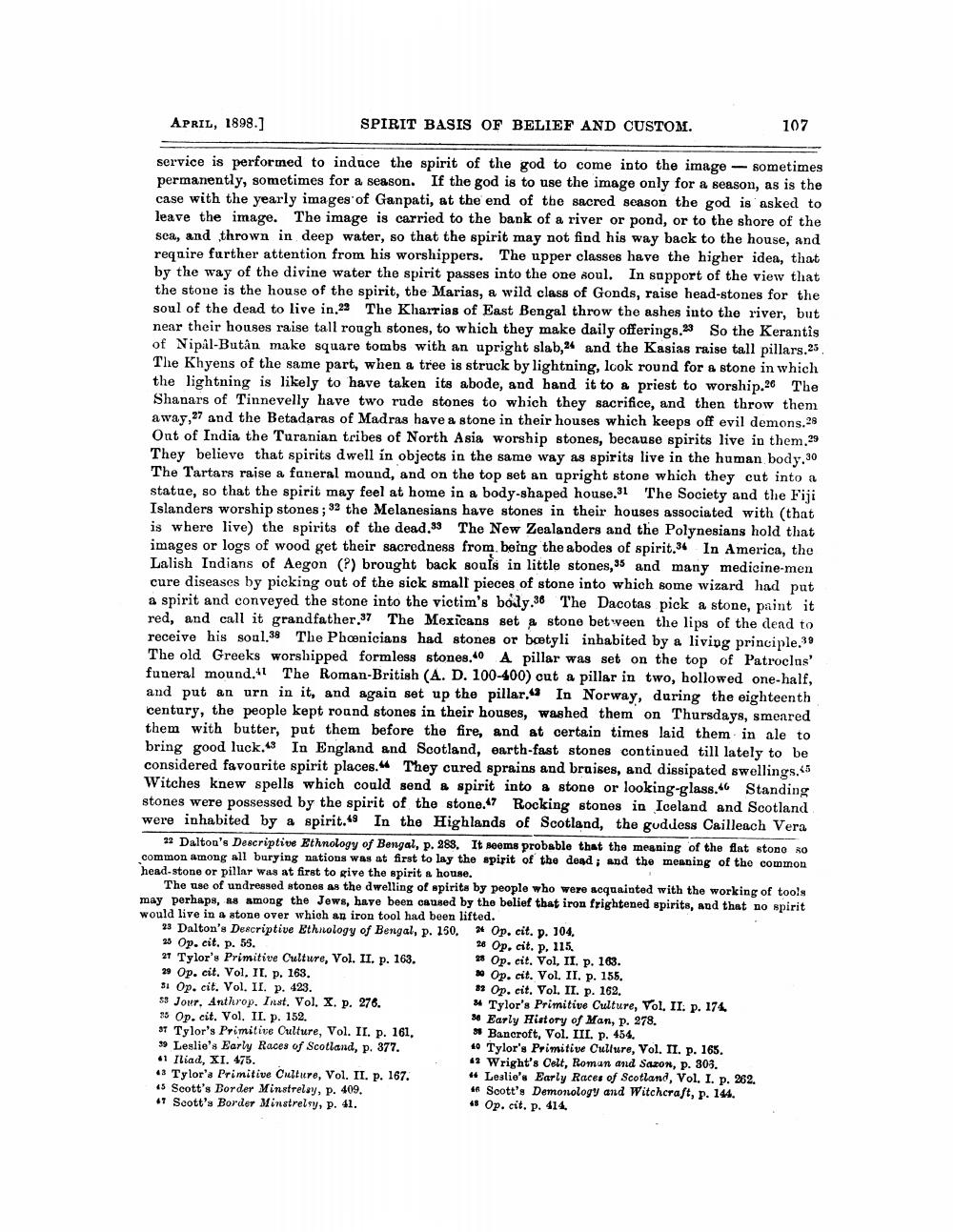________________
APRIL, 1898.)
SPIRIT BASIS OF BELIEF AND CUSTOM.
107
service is performed to induce the spirit of the god to come into the image - sometimes permanently, sometimes for a season. If the god is to use the image only for a season, as is the case with the yearly images of Ganpati, at the end of the sacred season the god is asked to leave the image. The image is carried to the bank of a river or pond, or to the shore of the sea, and thrown in deep water, so that the spirit may not find his way back to the house, and require further attention from his worshippers. The upper classes have the higher idea, that by the way of the divine water the spirit passes into the one soul. In sopport of the view that the stone is the house of the spirit, the Marias, a wild class of Gonds, raise head-stones for the soul of the dead to live in.22 The Kharrias of East Bengal throw the ashes into the river, but near their houses raise tall rough stones, to which they make daily offerings.23 So the Kerantis of Nipil-Butân make square tombs with an upright slab,24 and the Kasias raise tall pillars.25 The Khyens of the same part, when a tree is struck by lightning, look round for a stone in which the lightning is likely to have taken its abode, and hand it to a priest to worship.26 The Shanars of Tinnevelly have two rude stones to which they sacrifice, and then throw them away,37 and the Betadaras of Madras have a stone in their houses which keeps off evil demons.29 Ont of India the Turanian tribes of North Asia worship stones, because spirits live in them.29 They believe that spirits dwell in objects in the same way as spirits live in the human body. 30 The Tartars raise a faneral mound, and on the top set an apright stone which they cut into a statue, so that the spirit may feel at home in a body-shaped house 31 The Society and the Fiji Islanders worship stones; 32 the Melanesians have stones in their houses associated with (that is where live) the spirits of the dead.33 The New Zealanders and the Polynesians hold that images or logs of wood get their sacredness from being the abodes of spirit.34 In America, the Lalish Indians of Aegon (?) brought back souls in little stones," and many medicine-men cure diseases by picking out of the sick small pieces of stone into which some wizard had put a spirit and conveyed the stone into the victim's boly.36 The Dacotas pick a stone, paint it red, and call it grandfather.37 The Mexicans set a stone between the lips of the dead to receive his soul.39 The Phoenicians had stones or bcetyli inhabited by a living principle.39 The old Greeks worshipped formless stones. A pillar was set on the top of Patroclas' funeral mound.11 The Roman-British (A. D. 100-400) out a pillar in two, hollowed one-half, and put an urn in it, and again set up the pillar. In Norway, during the eighteenth century, the people kept round stones in their houses, washed them on Thursdays, smeared them with butter, put them before the fire, and at certain times laid them in ale to bring good luck." In England and Scotland, earth-fast stones continued till lately to be considered favourite spirit places. They cured sprains and braises, and dissipated swellings.15 Witches knew spells which could send & spirit into a stone or looking-glass. Standing stones were possessed by the spirit of the stone.7 Rocking stones in Iceland and Scotland were inhabited by a spirit. In the Highlands of Scotland, the guddess Cailleach Vera
22 Dalton's Descriptive Ethnology of Bengal, p. 288. It seems probable that the meaning of the flat stone so common among all burying nations was at first to lay the spirit of the dead; and the meaning of the common head-stone or pillar was at first to give the spirit a house.
The use of undressed stones as the dwelling of spirits by people who were acquainted with the working of tools may perhaps, 38 among the Jews, have been caused by the belief that iron frightened spirits, and that no spirit would live in a stone over which an iron tool had been lifted.
23 Dalton's Descriptive Ethnology of Bengal, p. 150. 2 Op. cit. p. 104. 25 Op. cit. p. 55.
26 Op. cit. p. 115. 21 Tylor's Primitive Culture, Vol. II. p. 163.
*Op. cit. Vol. II. p. 183. 29 Op. cit. Vol. II, p. 163.
30 Op. cit. Vol. II, p. 155. 51 Op. cit. Vol. II. p. 423.
33 Op. cit. Vol. II. p. 162. 53 Jour. Anthrop. Inst. Vol. X. p. 276.
34 Tylor's Primitive Culture, Vol. II. p. 174 5 Op. cit. Vol. II. p. 152.
S6 Early History of Man, p. 278. 37 Tylor's Primitive Culture, Vol. II. p. 161. * Bancroft, Vol. III. p. 454. 39 Leslie's Early Races of Scotland, p. 377.
40 Tylor's Primitive Culture, Vol. II. p. 165. 41 Iliad, XI. 475.
13 Wright's Celt, Roman and Sazon, p. 303. 13 Tylor'a Primitive Culture, Vol. II. p. 167.
# Leslie's Early Races of Scotland, Vol. I. p. 262. is Scott's Border Minstrelay, p. 409.
46 Scott's Demonology and Witchcraft, p. 144. *T Scott's Border Minstrelsy, p. 41.
45 Op. cit. p. 414.




